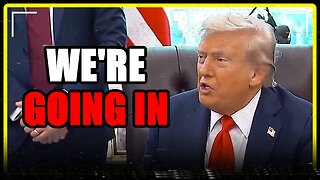Premium Only Content

How Even MORE Countries Can Join BRICS
Originally published on 12 August 2024.
A lot of country‘s wanna join BRICS, the hippest club in town for now. Just recently we heard that Malaysia has officially applied. But how exactly do you become a BRICS member? Well, to answer that, we‘ll first need to look at what BEICS exactly is and how its decision making works.
First of all, let‘s be clear about what BRICS is and how it defers from other international organisations. You see, there many types of international organisations, some are highly formalised like the UN, the EU, or NATO, which have one or several international treaties as their backbones—for the UN it’s the UN Charter, for the EU its the Lisbon treaty, and for NATO that’s the North Atlantic Treaty of 1949. These organisations also have permanent structures like the General Assembly and Security council for the UN. For the EU, the European council, the commission and the parliament are its central organs, and NATO has the North Atlantic Council together with a secretariat, in that spaceship in Brussels. All of these organs have defined jobs to do and wield certain powers inside the organisation.
Then, on the other hand, there are Organisation that are much less formalised. A good example is the G7, which has no international treaty behind it, nor permanent structures. The G7 is just the name for a club of countries that meets regularly on summit level—meaning the heads of state—or ministerial and lower levels, where they try to coordinate policies and work on joint issues. But they do that without a legally binding treaty that would need to be ratified by their parliaments and without permanent structures or headquarters.
BRICS—until now—is the same type of international organisation, a very informal one. There is no BRICS Treaty, at least not yet, and it’s unlikely that the block will ever create one since they are not planing on becoming a counter NATO or EU or something like that. There is also no headquarter or secretariat. The responsibility for keeping things together rests with all member states, especially the one holding the presidency.
However, that does not mean that there are no rules. Usually what happens is that these organisation create principles in documents that they circulate, that rely on all members being fine with them.
That‘s why BRICS, like the G7, functions on the principle of unanimity. All members need to be ok with what is happening or at least not oppose it. Otherwise they just won‘t participate in what‘s being discussed. Especially when it comes to membership, this is quite crucial. You might remember that there was a moment when the G7 became the G8 when they included Russia. But then after the invasion of Crimea Russia got kicked out simply by not being invited anymore.
Informal international organisations really function more like a school cliques rather than a school clubs. However, when these cliques are successful in moving things around, there is also an inevitable need for at least some degree of formalisation. This is why the idea of “BRICS” was actually introduced to the world not by any of its current members, but by Jim O’Neil, back in 2001, the then-chairman of Goldman Sachs. O’Neil simply argued in a paper that the GDP growth of the four original BRIC states, Brazil, Russia, India, and China were surpassing that of the G7, and hence the BRIC were a force to look out for in the near future. The actual four states simply picked up on the idea and met for a first time officially in 2009, in Russia, to discuss economic matters.
BRICS was then later extended to include South Africa, and last year, during the Johannesburg summit, the leaders adopted a formal catalogue of how further states can join, which lays this rather simple process out as follows.
-
 1:00:28
1:00:28
NeutralityStudies
1 month agoHow The USA Made The Srebrenica Massacre INEVITABLE | Prof. David Gibbs
1.06K1 -
 4:33:42
4:33:42
Drew Hernandez
9 hours agoISRAEL BOMBS GAZA HOSPITAL ON LIVE TV KILLING AT LEAST 20 INCLUDING JOURNALISTS & CIVILIANS
20.8K49 -
 2:55:23
2:55:23
TimcastIRL
8 hours agoTrump Orders Specialized National Guard Units To Combat Crime In Cities, Dems Furious | Timcast IRL
205K143 -
 6:22:03
6:22:03
SpartakusLIVE
9 hours ago#1 Rocket CHAMPION of Verdansk wields UNSTOPPABLE new META
81.3K5 -
 2:55:11
2:55:11
Barry Cunningham
9 hours agoPRESIDENT TRUMP MADE TODAY A VERY BAD DAY TO BE A DEMOCRAT!
100K63 -
 1:15:29
1:15:29
Flyover Conservatives
1 day agoFrom Cool to Cringe: How Democrats Lost America’s Ear | FOC Show
48.1K14 -
 8:19
8:19
MattMorseTV
12 hours ago $8.93 earnedTrump is ACTUALLY DOING IT.
48.5K43 -
 11:30:43
11:30:43
ZWOGs
15 hours ago🔴LIVE IN 1440p! - Tarkov w/ Casey & crgoodw1n, Kingdom Come Deliverance, & More - Come Hang Out!
40.6K5 -
 2:30:56
2:30:56
We Like Shooting
19 hours ago $8.72 earnedWe Like Shooting 625 (Gun Podcast)
40.3K1 -
 1:45:02
1:45:02
Glenn Greenwald
10 hours agoIsrael Slaughters More Journalists, Hiding War Crimes; Trump's Unconstitutional Flag Burning Ban; Glenn Takes Your Questions | SYSTEM UPDATE #504
142K215